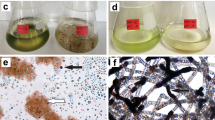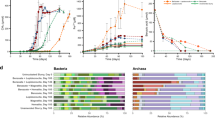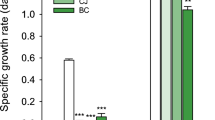Abstract
Microorganisms that use insoluble Fe(iii) oxide as an electron acceptor can have an important function in the carbon and nutrient cycles of aquatic sediments and in the bioremediation of organic and metal contaminants in groundwater1,2. Although Fe(iii) oxides are often abundant, Fe(iii)-reducing microbes are faced with the problem of how to access effectively an electron acceptor that can not diffuse to the cell. Fe(iii)-reducing microorganisms in the genus Shewanella have resolved this problem by releasing soluble quinones that can carry electrons from the cell surface to Fe(iii) oxide that is at a distance from the cell3,4. Here we report that another Fe(iii)-reducer, Geobacter metallireducens, has an alternative strategy for accessing Fe(iii) oxides. Geobacter metallireducens specifically expresses flagella and pili only when grown on insoluble Fe(iii) or Mn(iv) oxide, and is chemotactic towards Fe(ii) and Mn(ii) under these conditions. These results suggest that G. metallireducens senses when soluble electron acceptors are depleted and then synthesizes the appropriate appendages to permit it to search for, and establish contact with, insoluble Fe(iii) or Mn(iv) oxide. This approach to the use of an insoluble electron acceptor may explain why Geobacter species predominate over other Fe(iii) oxide-reducing microorganisms in a wide variety of sedimentary environments5,6,7,8.
This is a preview of subscription content, access via your institution
Access options
Subscribe to this journal
Receive 51 print issues and online access
$199.00 per year
only $3.90 per issue
Buy this article
- Purchase on Springer Link
- Instant access to full article PDF
Prices may be subject to local taxes which are calculated during checkout


Similar content being viewed by others
References
Thamdrup, B. Bacterial manganese and iron reduction in aquatic sediments. Adv. Microb. Ecol. 16, 41–84 (2000).
Lovley, D. R. Fe(iii) and Mn(iv) Reduction in Environmental Metal–Microbe Interactions (ed. Lovley, D. R.) 3–30 (ASM, Washington DC, 2000).
Newman, D. K. & Kolter, R. A role for excreted quinones in extracellular electron transfer. Nature 405, 94–97 (2000).
Nevin, K. P. & Lovley, D. R. in ASM 101st General Meeting 588 (ASM, Washington DC, 2001).
Rooney-Varga, J. N., Anderson, R. T., Fraga, J. L., Ringelberg, D. & Lovley, D. R. Microbial communities associated with anaerobic benzene degradation in a petroleum-contaminated aquifer. Appl. Microbiol. 65, 3056–3063 (1999).
Snoeyenbos-West, O. L., Nevin, K. P., Anderson, R. T. & Lovley, D. R. Enrichment of Geobacter species in response to stimulation of Fe(iii) reduction in sandy aquifer sediments. Microb. Ecol. 39, 153–167 (2000).
Röling, W. F. M., van Breukelen, B. M., Braster, M., Lin, B. & van Verseveld, H. W. Relationships between microbial community structure and hydrochemistry in a landfill leachate-polluted aquifer. Appl. Environ. Microbiol. 67, 4619–4629 (2001).
Stein, L. Y., La Duc, M. T., Grundl, T. J. & Nealson, K. H. Bacterial and archaeal populations associated with freshwater ferromanganous micronodules and sediments. Environ. Microbiol. 3, 10–18 (2001).
Lovley, D. R., Stolz, J. F., Nord, G. L. Jr & Phillips, E. J. P. Anaerobic production of magnetite by a dissimilatory iron-reducing bacterium. Nature 330, 252–254 (1987).
Lovley, D. R. & Phillips, E. J. P. P. Novel mode of microbial energy metabolism: organic carbon oxidation coupled to dissimilatory reduction of iron or manganese. Appl. Environ. Microbiol 54, 1472–1480 (1988).
Lovley, D. R. et al. Oxidation of aromatic contaminants coupled to microbial iron reduction. Nature 339, 297–299 (1989).
Lovley, D. R. et al. Geobacter metallireducens gen. nov. sp. nov., a microorganism capable of coupling the complete oxidation of organic compounds to the reduction of iron and other metals. Arch. Microbiol. 159, 336–344 (1993).
Henrichsen, J. Twitching motility. Annu. Rev. Microbiol. 37, 81–93 (1983).
Strom, M. S. & Lory, S. Structure-function and biogenesis of the type IV pili. Annu. Rev. Microbiol. 47, 565–596 (1993).
Wall, D. & Kaiser, D. Type IV pili and cell motility. Mol. Microbiol. 32, 1–10 (1999).
Alm, R. A. & Mattick, J. S. Genes involved in the biogenesis and function of type-4 fimbriae in Pseudomonas aeruginosa. Gene 192, 89–98 (1997).
Nevin, K. P. & Lovley, D. R. in ASM 100th General Meeting 598 (ASM, Washington DC, 2000).
Nealson, K. H., Moser, D. P. & Saffarini, D. A. Anaerobic electron acceptor chemotaxis in Shewanella putrefaciens. Appl. Environ. Microbiol 61, 1551–1554 (1995).
Macnab, R. M. in Escherichia coli and Salmonella: Cellular and Molecular Biology Vol. 1 (ed. Neidhardt, F. C. et al.) 123–145 (ASM, Washington DC, 1996).
Wu, S. S. & Kaiser, D. Regulation of expression of the pilA gene in Myxococcus xanthus. J. Bacteriol. 179, 7748–7758 (1997).
Phillips, E. J. P. & Lovley, D. R. Determination of ferric and ferrous iron in oxalate extracts of sediment. Soil Sci. Soc. Am. J. 51, 938–941 (1987).
Parales, R. E., Ditty, J. L. & Harwood, C. S. Toluene-degrading bacteria are chemotactic towards the environmental pollutants benzene, toluene and trichloroethylene. Appl. Environ. Microbiol. 66, 4098–4104 (2000).
Acknowledgements
We thank L.Yin and the Central Microscopy Facility at the University of Massachusetts for assistance with transmission electron microscopy. Preliminary sequence data was obtained from The Institute for Genomic Research website at http://www.tigr.org. This research was supported with grants from the Office of Biological and Environmental Research of the Department of Energy and the National Science Foundation.
Author information
Authors and Affiliations
Corresponding author
Ethics declarations
Competing interests
The authors declare that they have no competing financial interests
Rights and permissions
About this article
Cite this article
Childers, S., Ciufo, S. & Lovley, D. Geobacter metallireducens accesses insoluble Fe(iii) oxide by chemotaxis. Nature 416, 767–769 (2002). https://doi.org/10.1038/416767a
Received:
Accepted:
Issue Date:
DOI: https://doi.org/10.1038/416767a
This article is cited by
-
Sediment microbial fuel cells for bioremediation of pollutants and power generation: a review
Environmental Chemistry Letters (2023)
-
Electromicrobiology: the ecophysiology of phylogenetically diverse electroactive microorganisms
Nature Reviews Microbiology (2022)
-
Comparative insights into genome signatures of ferric iron oxide- and anode-stimulated Desulfuromonas spp. strains
BMC Genomics (2021)
-
Electricigens and microbial fuel cells for bioremediation and bioenergy production: a review
Environmental Chemistry Letters (2021)
-
Global transcriptional analysis of Geobacter sulfurreducens under palladium reducing conditions reveals new key cytochromes involved
Applied Microbiology and Biotechnology (2020)
Comments
By submitting a comment you agree to abide by our Terms and Community Guidelines. If you find something abusive or that does not comply with our terms or guidelines please flag it as inappropriate.



